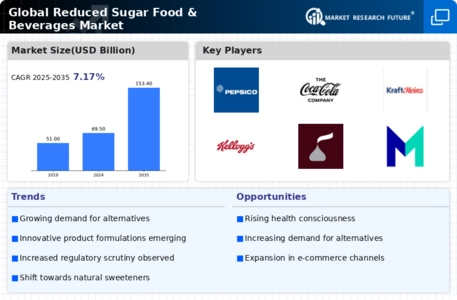Market Trends
Key Emerging Trends in the Reduced Sugar food beverage Market
The Reduced Sugar Food and Beverage market are undergoing significant shifts in response to evolving consumer preferences, health-conscious choices, and regulatory considerations. One of the primary drivers shaping the market dynamics is the increasing awareness of the health risks associated with high sugar consumption. Consumers, now more than ever, are scrutinizing food and beverage labels and seeking products that align with their desire for reduced sugar intake. This heightened health consciousness has spurred a dynamic market environment, prompting food and beverage manufacturers to reformulate their offerings to meet the demand for reduced sugar options.
Changing consumer attitudes towards sugar have played a pivotal role in shaping the dynamics of the Reduced Sugar Food and Beverage market. As individuals become more mindful of their dietary habits, there is a growing demand for products that provide the sweetness consumers crave without the negative health impacts of excessive sugar. The market has responded with a proliferation of reduced sugar alternatives, ranging from beverages and snacks to baked goods and condiments. This shift reflects a broader trend where consumers prioritize healthier choices without compromising on taste, influencing the overall landscape of the food and beverage industry.
Regulatory initiatives and guidelines advocating for reduced sugar consumption have also significantly impacted the market dynamics of reduced sugar food and beverages. Governments and health organizations worldwide are implementing measures to address the rising concerns related to obesity and chronic diseases linked to high sugar intake. This has led to increased scrutiny of products, encouraging manufacturers to incorporate reduced sugar formulations to comply with regulatory standards. The market is, therefore, influenced not only by consumer demand but also by the evolving regulatory environment that encourages healthier product offerings.
Innovation within the food and beverage industry has been a key driver of market dynamics in the Reduced Sugar segment. Manufacturers are continually exploring novel formulations, incorporating sugar substitutes, natural sweeteners, and innovative technologies to reduce sugar content without compromising taste and quality. This dynamic response to consumer preferences has led to an expanding range of reduced sugar products, offering consumers diverse choices that cater to different taste profiles and dietary requirements.
The demand for natural sweeteners and plant-based alternatives has emerged as a significant trend influencing the Reduced Sugar Food and Beverage market dynamics. Consumers are increasingly drawn to products sweetened with natural alternatives like stevia, monk fruit, and erythritol. These sweeteners provide a healthier option without sacrificing sweetness, aligning with the broader trend of plant-based eating and clean label preferences. This shift in consumer behavior has prompted food and beverage manufacturers to explore and incorporate these natural sweeteners, further diversifying the reduced sugar product offerings.
Retail and distribution channels play a crucial role in shaping the accessibility and visibility of reduced sugar products in the market. The dynamics are influenced by the strategic placement of these products in supermarkets, health food stores, and online platforms. The collaboration between reduced sugar ingredient suppliers and food manufacturers, along with effective marketing strategies, contributes to the successful penetration of these products into the consumer market.
Despite the positive market dynamics, challenges such as taste perception, consumer education, and cost considerations remain. Overcoming these challenges requires ongoing research and development, transparent communication about reduced sugar formulations, and efforts to enhance the overall taste experience of reduced sugar products. The industry's ability to address these challenges and adapt to evolving consumer preferences will determine the sustained growth and success of the Reduced Sugar Food and Beverage market. In conclusion, the market dynamics reflect a dynamic interplay of health trends, regulatory influences, industry innovations, and consumer choices, shaping an environment where reduced sugar options are increasingly becoming integral to the food and beverage landscape.











Leave a Comment